A Living Foundation Beneath the Vine
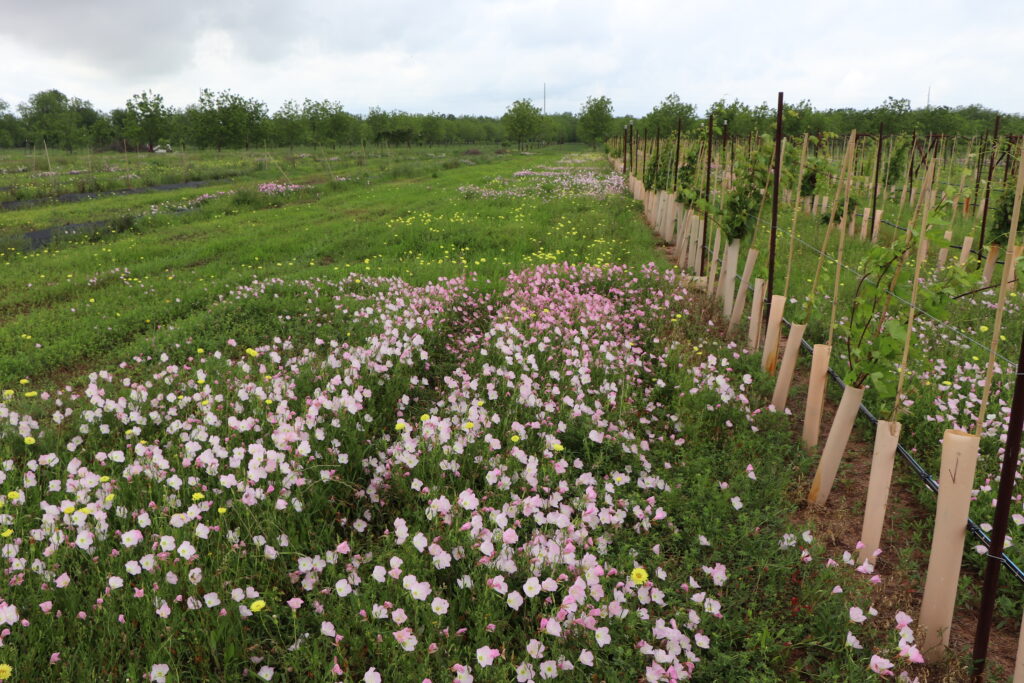
Cover Crop of Native Texas Wildflowers in the Texas Gulf Coast
By: Daniel Hillin and Justin Scheiner, Ph.D. – Texas A&M AgriLife Extension Service
Soil is more than just the ground beneath our boots. For grape growers, it is the living foundation of every vine, vintage, and bottle. Sometimes overlooked as just an inert medium, soil is now understood as an extremely complex and dynamic ecosystem. The concept of “soil health” has emerged as a cornerstone of modern viticulture, blending ecology, chemistry, biology, and sustainability. But what exactly is soil health, and what all does it encompass?
The USDA Natural Resources Conservation Service (NRCS) defines soil health as “the continued capacity of soil to function as a vital living ecosystem that sustains plants, animals, and humans.” It’s a functional definition that shifts the focus from soil as a passive growing material to one that is alive and responsive. Unlike “soil quality,” which often refers to inherent characteristics like texture or fertility, soil health emphasizes the dynamic, living processes that can be improved or degraded over time.
The Biological, Chemical, and Physical Components
At the heart of soil health is life itself. Billions of bacteria, fungi, protozoa, nematodes, and arthropods form a vibrant web underground, collectively known as the soil food web. These organisms decompose organic material, cycle nutrients, build soil structure, and suppress pathogen activity. In vineyards, a diverse and active biological community helps buffer vines against stress while simultaneously supporting nutrient uptake. For example, mycorrhizal fungi form symbiotic relationships with grapevine root systems, thus extending their access to water and certain nutrients. In Texas vineyards, especially those with minimal tillage and ground cover, growers report higher earthworm activity and microbial respiration rates—an encouraging sign of thriving biology.
Healthy soil must also provide the chemical building blocks of plant growth. This includes essential nutrients such as nitrogen, phosphorus, potassium, magnesium, calcium, and a suite of micronutrients such as iron, zinc, and boron. Nutrient availability depends not just on how much is present, but how accessible those nutrients are to plants. Soil pH, salinity, and cation exchange capacity (CEC) all influence nutrient dynamics in the soil and ultimately the amount of nutrients available to the plant. In many Texas vineyards, high-pH calcareous soils can tie up micronutrients like iron and zinc, leading to deficiencies even when these nutrients are present in adequate quantities. Maintaining balanced fertility through soil and petiole analysis and amendments is key to supporting chemical soil health.
The physical structure of soil influences everything from water infiltration to root growth. Soil texture (sand, silt, clay), aggregate stability, and bulk density all play a role in shaping the vines root environment. Healthy physical properties help support vigorous root systems, allow for both timely drainage and water retention, and help mitigate soils from compaction and erosion from everyday vineyard tasks.
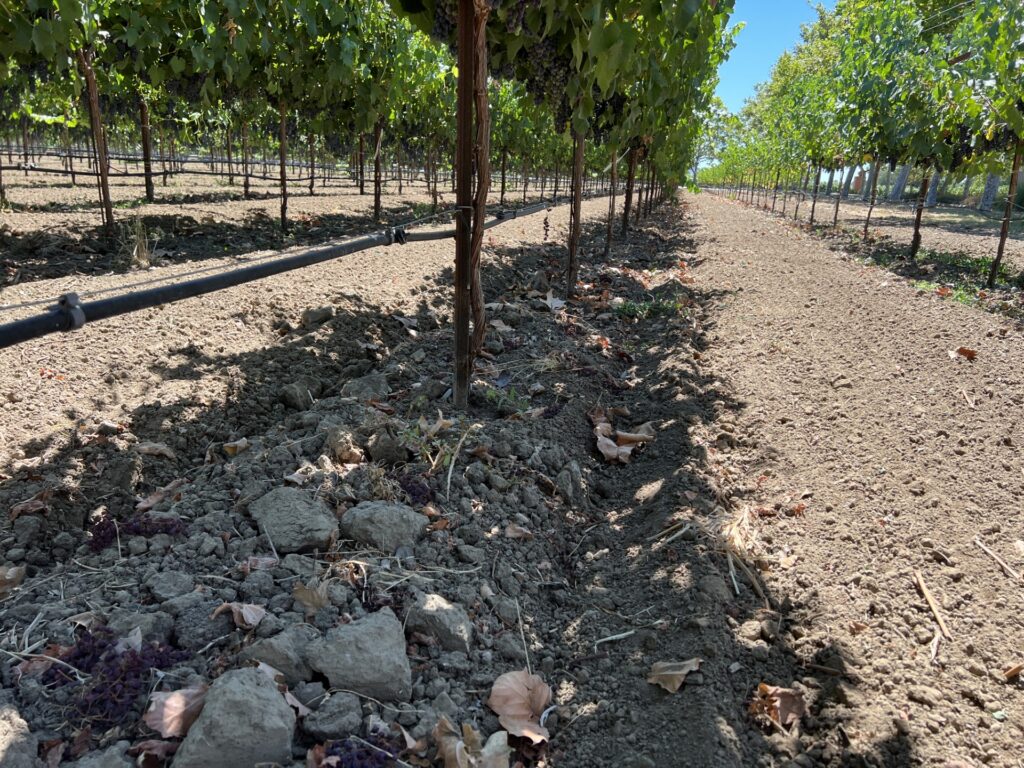
Click Series Gravelly Soil Under Vine in the Texas Hill Country
Soils in the Texas High Plains AVA are often deep and sandy with good drainage, while some areas in the Texoma and Hill Country AVAs tend toward heavier clay soils that can compact easily. In vineyard systems, with frequent traffic, narrow row spacing, and fixed irrigation lines are common, compaction becomes a critical concern. Growers can enhance physical soil health by minimizing mechanical disturbance, avoiding traffic on wet soils, and incorporating organic matter to improve structure.
Often called the “gold standard” of soil health, organic matter is central to physical, chemical, and biological functioning. It improves water-holding capacity, fuels microbial life, and increases the ability of the soil to retain nutrients. In soils with naturally low organic matter, increasing soil organic matter (SOM) levels in vineyards is a process that requires a long-term investment. Practices such as compost applications, cover cropping, reduced tillage, and mulching can incrementally build organic matter content year to year. In Texas, where soil organic content is naturally low due to high temperatures and erosion risk, establishing and maintaining a cover crop and adding compost or biochar can make a significant difference.
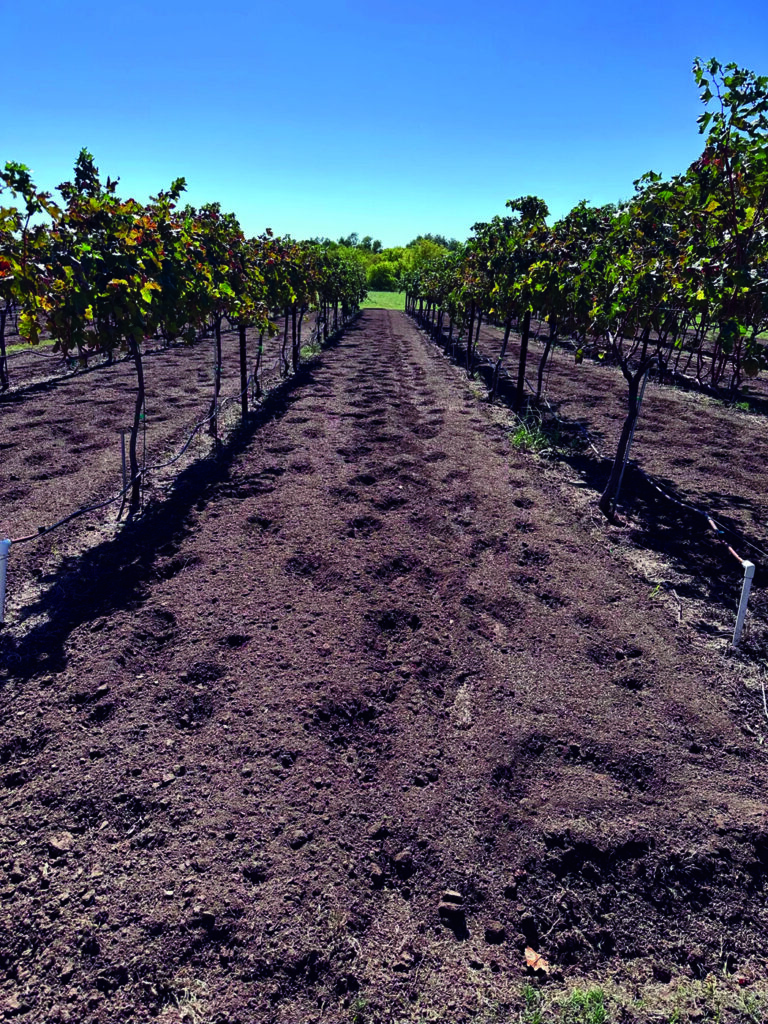
Medlin Clay Soil Midrow in the North Texas Region
Managing Soil Health in Vineyards
Soil health can be observed in the field and measured in the lab. Observable indicators include aggregate stability, root depth, soil smell, and biological activity (like earthworms). Lab tests might assess organic matter content, microbial respiration, bulk density, or nutrient profiles. While no single test captures all aspects of soil health, combining multiple indicators over time helps growers make informed decisions. Some vineyards are beginning to adopt composite soil health indices that synthesize biological, chemical, and physical data into one management tool.
Soil health in vineyards is not static, it is something growers can actively build through thoughtful, region-specific management. Key practices begin with minimizing soil disturbance by reducing tillage and avoiding equipment passes when soils are wet, especially in heavy clay regions prone to compaction. Protecting the soil surface with cover crops or mulches not only guards against erosion but also supports biological activity and enhances organic matter over time. Cover crops improve soil structure by creating pore spaces, regulating soil temperature extremes, and increasing water infiltration, especially after rainfall.
Organic matter contributes to thermal regulation in the root zone, protecting vines from temperature extremes. Texas soils, especially in the High Plains and Hill Country, often suffer from naturally
low organic content due to warm climates that accelerate decomposition. Adding compost, tilled cover crop residue, or biochar, and selecting materials with balanced carbon-to-nitrogen ratios help stimulate microbial life and lessen nutrient immobilization.
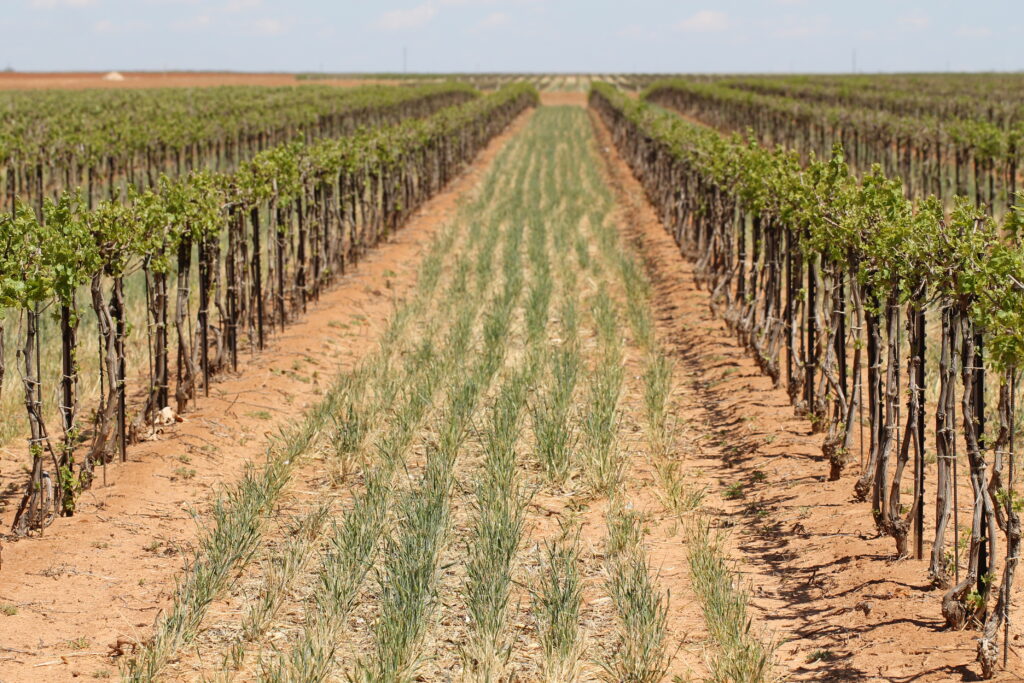
Annual Ryegrass Utilized as a Cover Crop in the Texas High Plains Region
Proper drainage is another critical factor. In poorly draining soils, growers are encouraged to conduct percolation tests and consider pre-plant interventions like subsoiling or installing French drains. For clay-heavy soils, deep ripping before planting and inter-row cover crops can help break up compaction layers. Sandy soils, though well-drained, may struggle with nutrient leaching requiring split fertilizer applications and nematode-resistant rootstocks.
Ultimately, managing soil health is a holistic, site-adapted process. Incorporating these strategies improves vine performance and ensures optimal vine health in the face of Texas’s highly variable climate while contributing to consistent wine quality.
Texas Terroir: Soil Diversity and Potential
Texas’s diverse wine regions—High Plains, Hill Country, North Texas, West Texas, and the Gulf Coast—showcase a broad spectrum of soil types that shape not only how grapes grow but also how wines taste. Each region presents unique soil-driven opportunities and challenges for the vineyard management approaches and ultimately the wine expression.
High Plains: The Texas High Plains, known for its elevation and arid climate, is dominated by well-drained sandy loam soils over a layer of caliche. These soils allow deep root penetration and efficient drainage, reducing disease pressure. However, they tend to be low in organic matter and nutrients, requiring strategic inputs such as fertilizer, cover crops, and irrigation. Wines from this region often exhibit full bodied styles with pronounced fruit character.
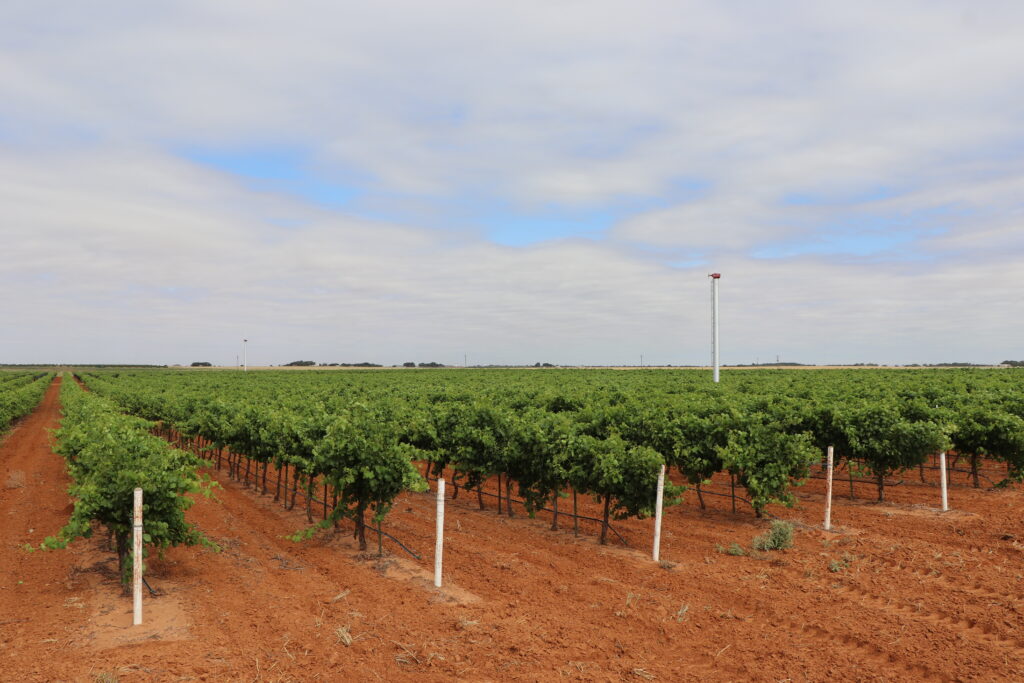
Amarillo Fine Sandy Loam Soil in the Texas High Plains Region
Hill Country: Soils in the Hill Country are as varied as its landscape, everything including granite-based sandy loams, shallow limestone, and even clay-rich profiles. Wineries report that local limestone-based soils impart a distinct minerality to wines and these soils are prized for their drainage and root penetration qualities. The mix of soil types enables a wide range of grape varieties to thrive, including Tempranillo, Viognier, and Mourvèdre.
North Texas: This region, encompassing the Texoma area, features soils with high clay content and silty loam overlays. These soils can retain water well but may require aeration and organic matter to improve structure and avoid compaction. The historical roots of grape growing in this area, especially with both hybrid and vinifera varieties, are well-suited to the regional soils and climate.
West Texas: West Texas includes parts of the Davis Mountains and desert-influenced zones with volcanic, granitic, and calcareous soils. These high-elevation soils are often shallow and rocky but mineral-rich, offering excellent drainage and imparting complexity to wines. Managing soil structure and organic content is vital in this region, where water retention can be a challenge.
Gulf Coast: The Gulf Coast wine region features flatter terrain with sandy, often acidic soils and high humidity. While disease pressure is higher, the well-drained sandy soils help minimize root zone saturation. Grape varieties like Blanc du Bois and Black Spanish, and the new UC Davis “Walker Varieties” known for their resistance to Pierce’s Disease, thrive in these conditions. Maintaining organic matter and cover crops is key to controlling vine vigor and maintaining soil resilience.
This soil diversity across Texas is not just an environmental feature, it’s a functional tool that can be utilized. By understanding the foundational properties of their region’s soils, growers can make informed decisions about vineyard designs, rootstock selection, fertility management, and irrigation rates, all of which directly impact wine quality and vineyard longevity.
Overall, soil health is not a singular trait. It is the integration of biology, chemistry, and physics, shaped by time, management, and environment. For grape growers, cultivating healthy soils is as foundational as pruning or irrigation. In Texas and beyond, managing soil as a living ecosystem is no longer a luxury, it’s a necessity for long-term vineyard sustainability. Investing in soil health means investing in the future of the vine, the vineyard, and the wine itself.
References
Helwi, P. 2020. Nitrogen Management in Vineyards. Texas A&M AgriLIfe Extension Service. HORT-EHT-143.
Lazcano, C., Decock, C. and Wilson, S.G., 2020. Defining and managing for healthy vineyard soils, intersections with the concept of terroir. Frontiers in Environmental Science, 8, p.68.
Scheiner, J., and M. Cook. 2024. Understanding Vineyard Soils. Texas A&M AgriLIfe Extension Service. HORT-PU-290.


